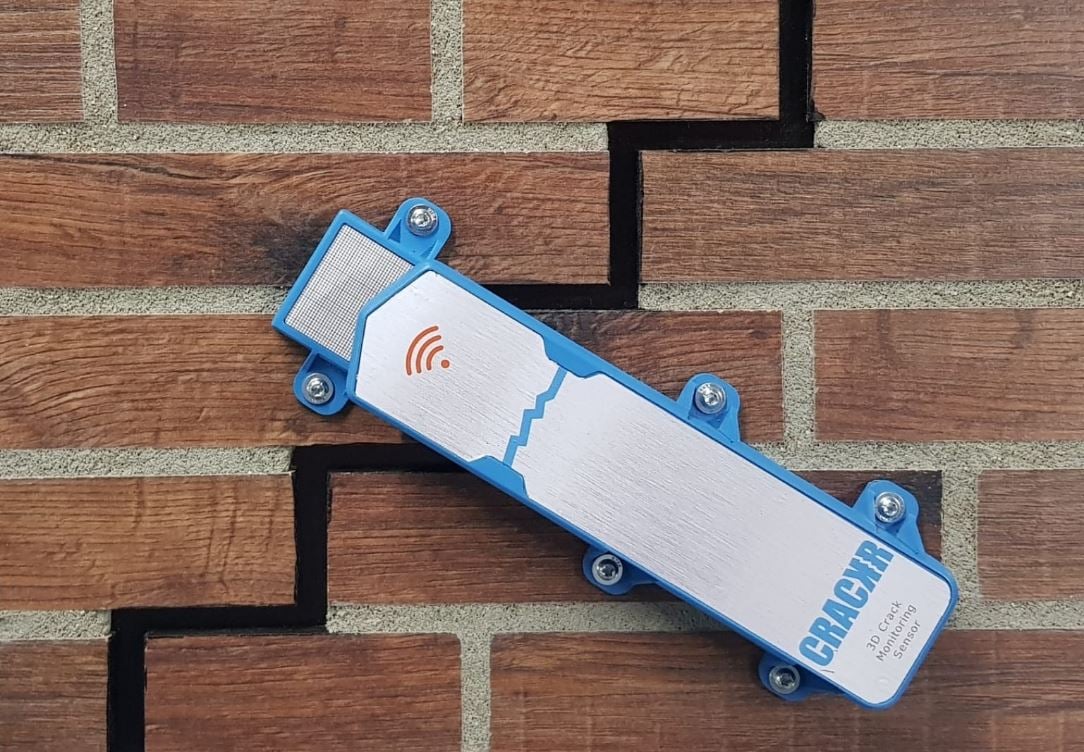
StabiAlert, a company from the Dutch city of Groningen that uses sensors to accurately measure tilt and vibration in places where it is crucial, is ready for the next step and is developing a new sensor: the CrackR. Twelve years ago, Arjen Miedema founded the company with Jeroen Kleef and Reinier Brongers in the earthquake zone in Groningen, where this sensor technology is used to map earthquake damage. Today, the sensors are used worldwide: on the U-bahn in Berlin and in large apartment buildings in San Francisco where subsidence is a looming threat.
The different types of sensors that the Groningen-based company launched on the market are similar to each other but each incorporates unique features. The first sensor developed, the high-frequency tiltsensor, measures at a frequency of 100Hz per second. It is used when every second counts, for example on a construction site when the safety of construction workers is at stake. The new digital crack sensor currently under development, has a different function and provides a value once an hour and can be used by housing associations and private individuals to observe damage to a wall. The sensor transmits signals using the 5G network.
Co-founder Arjen Miedema explained to us how things are progressing with StabiAlert and the development of the new digital sensor.

How exactly does the new CrackR sensor work?
“It is a digital sensor that can measure a crack remotely for years at a time, in 3D. A number of magnetic sensor elements are placed above a magnet and, with the help of mathematical algorithms, three vectors are calculated that show the 3D movement of a crack. The sensor data is sent to an app once an hour. Through the app, you can track whether any changes have occurred and set alarm triggers to receive alerts. We are currently working on a final version of the product and plan to introduce it to the market early next year.”
What are the advantages of this kind of digital crack meter over regular meters?
“First of all, this measurement method is simpler. At the moment, complicated constructions are often used in which a signal from an electronic strain gauge goes to the Wi-Fi box, from there it sends another signal to a solar panel, and so on. Secondly, the solution is extremely cost-effective. If you hang up a regular meter in someone’s home, and a company has to drive by ten times to come and measure a crack, that costs an awful lot of time and money. What’s more, all that driving back and forth obviously makes a huge difference in emissions. So, the meter leads to reductions in CO2. The data is also much more reliable. You can take standardized measurements and the app always keeps the data structured. Then, you can do things with that data, of course.”
Data is very important to you all. What can you actually do with that collected crack-related data?
“A housing cooperation can make decisions based on a bundle of structured data from houses, which is collected using the CrackR. For instance, you can run artificial intelligence on it that predicts when and what maintenance needs to be done on the homes. Moreover, the sensor can be used in infrastructure. Many roads and bridges are becoming outdated and with the help of our data we can better predict which projects should take place first and which can be postponed for a while. There is limited government money available for maintenance projects so this data can really play a crucial role.”
Not only in the Netherlands are housing associations and other companies interested in your applications. How are StabiAlert’s international projects coming along?
We are indeed also active in Germany, Belgium and in the United States. For example, we have been working for three years on a project involving the U-bahn in Berlin. At one particular point, the subway runs above the ground. This is where we measure deformation on a bridge with our combined tilt-accelerometers so that we can be sure that the trains can keep on running there safely during the work.
“In San Francisco, we have a long-term project where we are conducting monitoring at a location in the city where they are erecting a large 300-foot-tall building on Market Street. This is because there are a number of tall buildings next to it, and we are monitoring here to make sure that the surrounding buildings are not warping. Again, we measure with tilt-accelerometers any potential deformation or misalignment as a result of the construction work”
StabiAlert has undergone substantial growth in recent years. Where do you hope the company will be in a few years from now?
“In a few years, I hope that we will have accomplished good growth with the new sensor. It will be a type of sensor that can be easily used by the masses, so I hope that we will get even more exposure by doing that. There are a number of steps that need to be taken to make that happen. We need to further develop the app and work on the hardware and software. So, until the launch of the sensor early next year, we are completely booked up.”
Read other stories about Groningen via this link.

